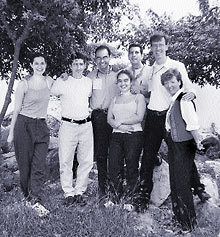|
|
|
|
|
|
|
 |
|
|
Bill Purcell (second from right), director of the Office for Peace
and Justice, was one of a diverse group from Colombia, Ecuador
and the United States who met to explore ways to bring hope to
one of the most dangerous countries in the world. Photo by Sandy Berto |
|
Colombia: from crucifixion to resurrection
By Bill Purcell
SPECIAL CONTRIBUTOR
Humbling! That is the word I keep using when asked how my trip
to Colombia with Catholic Relief Services (CRS) went. I have spent
most of the past 15 years working on the social mission of the
Catholic Church, and the faithful people I met in Colombia were
some of the most true to the Gospel I have ever known. Many of
them are religious leaders of all sorts who have seen people crucified
by ideologues on both sides for standing up for respect for human
dignity.
Going to Colombia a few weeks ago, I was very apprehensive. In
fact, I told Catholic Relief Services to send someone else from
the Office for Peace and Justice since I did not speak Spanish
or even have a passport. They said they needed me to speak to
various CRS partners about how U.S. (arch) dioceses work on social
ministry. I knew then that God was going to make sure that I had
firsthand experience of Lent.
|
|
|
|
|
|
|
|
|
|
‘I felt this Lent that I was called to move beyond my comfort
zone and see the Gospel in another light.’
|
|
As the father of two young boys, I wondered why I agreed to this
trip. I knew that Colombia is listed as one of the most dangerous
countries in the world and is the kidnapping capital of the world.
Some 3,000 civilians die of political violence there every year.
Almost 2 million people have been displaced. The violence comes
from a complexity of social and political conflicts over 40 years.
However, it has recently intensified due in part to substantial
drug-related profits received from armed aggressors on all sides.
But I felt this Lent that I was called to move beyond my comfort
zone and see the Gospel in another light.
Flying to Bogota from Miami, it was eerie being on a plane that
was half full. (It was packed on the way back.) Going through
customs with young soldiers with big guns with none of us knowing
how to communicate invited suspicion from both sides. It was comforting
to see the familiar face of a CRS staff member and go to the Colombian
Bishops Conference which, ironically, is wedged between a military
school and a women’s prison. Then a bus and a caravan of cars
traveled for two hours from the modern city of Bogota to a retreat
center in Chinauta.
What I experienced over the next few days was not the American
stereotype of Colombians as drug traffickers and caricatures of
Juan Valdez. I encountered brave and holy people.
Hope was the key element expressed by all 11 representative groups
of the projects CRS is supporting. There was also sadness, knowing
that conflict was the motivation that brought this diverse group
together from throughout Colombia, Ecuador and the United States.
But by each group working to provide alternatives to war, hope
was provided. Group after group struck my consciousness.
One group that especially touched my heart was from the Diocese
of Quibdo, made up of a nun, a priest, an indigenous person and
an Afro-Colombian. Through song they introduced how they stood
up for human rights against forces from all sides in the Choco
region of Colombia. They had an intensity of spirit, yet a groundedness
in reflection. At the end of the conference, they wrote a note
thanking the American people for praying for them and being in
solidarity with them.
The spirit of many of the women was powerful. One was literally
named hope, Esperanza. She was one of the most reserved people
in the group. During morning prayer one day she shared how her
husband disappeared for four days. When she found him dead after
days of torture, all she could do was pray to God to forgive the
people who could treat a human being so terribly. The strength
of her witness and horror of her experience brought us all to
tears.
Another woman, Gloria, told us that when a guerrilla or a paramilitary
group comes to a town, the prettiest women in town are made their
servants in order to psychologically control the morale of a town.
A portion of our time was spent planning to work together. One
comment I wrote then I will carry as a theme throughout my life:
“We need to plan for transition, not just for our dreams so that
people do not fall into despair.” That was precisely what kept
these people going.
These Colombians and Ecuadorians were standing face to face with
the modern day crucifixions of Christ. However, they made drastic
adjustments in their lives in order to continue to follow Christ
so that they would not lose the vision of the resurrection. May
God strengthen us to pray, advocate and walk with these modern
day disciples for peace.
Purcell is director of the archdiocese’s Office for Peace and
Justice. For more information about how to assist Catholic Relief
Services in Colombia, contact the Office for Peace and Justice
(312) 751-8390.
Front Page | Digest | Cardinal | Interview
Classifieds | About Us | Write Us | Subscribe | Advertise
Archive | Catholic Sites | New World Publications | Católico | Directory | Site Map
|






